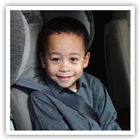You are here
Bike Safety for Big Kids
Passenger Safety for Big Kids
 Why use a booster seat?
Why use a booster seat?
- Keep your growing passenger safe. A booster seat provides a step between a car seat with a harness and a seat belt alone. It boosts the child for a safer and more comfortable fit of the adult seat belt.
- Is it time to move to a booster seat? Make sure your child exceeds the weight or height limits allowed in her forward-facing car seat. The child must also be mature enough to ride without climbing out of the booster. What does “mature enough” mean? She needs to stay in the booster seat the entire ride with the seat belt properly fitted across the shoulder and below the hips.
Types of Booster Seats
- High back booster. This type is best if your vehicle has a low seat back and no head rest. Like adults, children need support behind their heads. A high-back booster may also be good for younger children who fall asleep in the car or who like the extra comfort and a place to lean their heads.
- Backless booster. This type may be more convenient if you carpool or travel. It is typically less expensive. However, the vehicle must have a seat back high enough to provide support behind your child’s head. A backless booster can’t be seen from outside the car, so it is ideal for an older but smaller child who is embarrassed to still need a “boost.”
Installing Your Booster Seat
- Booster seats do not need to be installed. And you don’t need to worry about a tight fit. Your child’s weight on the booster seat holds it in place. The seat belt keeps the child in place. Watch the video.
- In the back seat. Use the booster seat in a back seat.
- Secure with seat belt. When the booster seat is not being used, secure it with the seat belt so it doesn’t fly around the car if you stop suddenly.
- Use the lap and shoulder seat belt. You no longer need a harness because the child and booster seat are held in place by the adult lap and shoulder belt.
The Right Fit for Your Booster Seat
- Getting a safe ride. A booster seat lifts a child’s body so the adult seat belt can fit properly. The seat belt must lie flat across your child’s chest, is on the bony part of his shoulder and is low on the hips or upper thighs.
- Using the seat belt. The booster seat is specifically designed for seat belt fit. Follow the arrows or guides on the booster seat that show you where to place the lap and shoulder belts. This will protect the child’s face, neck and belly.
- Watch for this common problem. Make sure your child doesn’t put the shoulder belt behind her back or under her arm. If she must do that to be comfortable, it’s best to use a car seat with a harness or a different booster seat with an adjustable shoulder belt guide.
Ready for the Seat Belt?
- Don’t be in a hurry. Your child is safer in a booster seat until the adult seat belt fits correctly, usually between the ages of 8 and 12. Seat belt fit is pretty much about height, not age.
- Find out if your child is ready for the seat belt alone. Learn about the Seat Belt Fit Test.
Be a Good Example
- Wear your seat belt. When adults wear seat belts, kids wear seat belts. Be sure everyone in the vehicle buckles up, too. Setting that good example starts when kids turn forward facing in the car after age 2 or more. Your child is watching everything you do.
- Plan for the carpool. When carpooling, make sure you have enough seating positions and booster seats for every child in your car and that kids enter and exit curbside.


